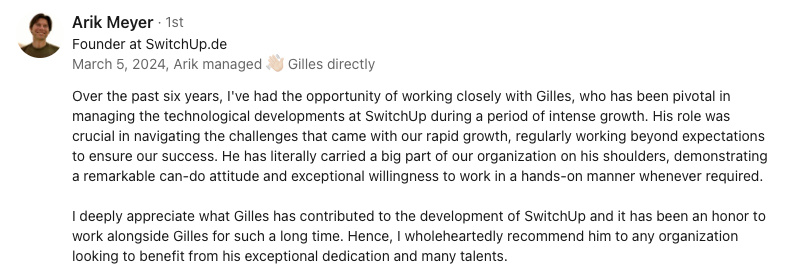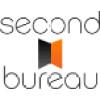Abstract:
The article emphasizes that leaving a tech job, particularly in Europe, is far more complex than following a basic checklist, due to legal requirements, cultural expectations, and intricate team dynamics that often go unnoticed. It introduces systems thinking as a practical and flexible approach to manage the unpredictability of job transitions, advocating for mapping out how different people, processes, and tasks interconnect to reduce stress and avoid overlooked risks. Practical tools like influence diagrams, dependency matrices, and feedback loops are recommended to visualize dependencies, adapt plans in real time, and balance professional responsibilities with personal wellbeing. A detailed example of a senior developer resigning from a German tech company illustrates how legal notice periods, cross-border handover challenges, and support structures (like works councils) play into a successful transition. The article stands out for its actionable templates, step-by-step systems mapping guidance, and emphasis on integrating both work and personal milestones, ultimately showing how treating an exit as a living system—rather than a linear process—can turn a potentially chaotic experience into a manageable, even positive, transition.
Leaving a tech job is rarely just ticking boxes on a checklist. There’s always more going on beneath the surface: legal quirks, cultural expectations, shifting timelines, and those subtle connections that can make or break how smoothly things go. I’ve learned this the hard way—each step you take can have effects you might not expect. Systems thinking has helped me bring a smarter, more flexible approach, especially here in Europe, where notice periods and workplace traditions can catch even seasoned planners off guard.
I want to share how seeing your exit as a system can help you handle what often feels unpredictable and messy. A linear plan is rarely enough. Mapping out how different people, teams, and priorities connect can make everything less stressful. I’ll walk you through practical tools like influence diagrams, dependency maps, and—yes—how to build your own Gantt chart or milestone checklist. I’ll also share advice for using feedback loops, picking the right order for big tasks, and balancing your job with your wellbeing. Along the way, I’ll sprinkle in some stories from my own transitions, from Berlin to Lisbon, and lessons learned leading cross-border teams.
There’s even a step-by-step example of leaving a tech job in Germany, drawn from my own experience as CTO in Berlin. At the end, you’ll find simple templates and checklists you can use—no complicated software or buzzwords needed. Instead of chaos, this approach can turn a stressful exit into something much more manageable.
Why systems thinking changes how you leave your tech job
Linear checklists miss how exits really work
Most people rely on a basic checklist: hand off projects, return your computer, say goodbye. But things rarely go that smoothly. A late project handoff might not only delay timelines—it can also worry clients or complicate your own plans. Even the best checklist can fall apart if one thing changes, leading to last-minute drama. Especially in fast-paced tech jobs, flexibility matters more than any perfect plan.
Standard templates assume that checking every box means your exit will be easy. But these usually miss the local surprises, legal slowdowns, and people issues that come with working in tech across Europe. Notice periods in Germany can last several months, while in the UK they might be much shorter. If your plan is too rigid, you might miss these differences and run into trouble, sometimes even harming relationships with your team or manager.
Linear plans are bad at handling changes and feedback. Miss one meeting, and the whole thing might crumble. This can leave people feeling anxious or sidelined, making what should be a positive step stressful instead. Taking a broader view keeps you ready for curveballs and helps maintain good connections with colleagues.
Systems thinking reveals the hidden web
Looking at your exit as a system means paying attention to how everything connects—people, processes, and key moments. Instead of seeing each task separately, I map out how things like preparing documentation early affect not just project handoffs but also how my team and clients feel about the transition. That makes it easier to see where a small change can really help, taking some pressure off the process.
This isn’t about making things harder. Visualizing how events and people link together actually keeps things simpler. For me, with a physics background, these mapping habits come naturally. In any big change—switching countries or launching a business—tracing connections helps avoid the biggest surprises.
Things don’t always go step by step. Tiny miscommunications can turn into bigger headaches, while a quick meeting might prevent a week’s worth of problems. Seeing these patterns means your exit plan can adjust in real time, giving you more breathing room.
Mapping your exit system
Breaking down your exit into key domains
Leaving a job is more than finishing a list. It’s a set of overlapping areas that need attention. I like to break it down into:
- Notice period: Controls the overall timing and helps you line up other key steps.
- Project handoff and knowledge sharing: Making sure important info isn’t lost.
- Stakeholder engagement: Keeping teams, clients, and your boss in the loop—this can be the difference between a good send-off and confusion.
- Admin and logistics: Collecting equipment, handling IT accounts, sorting paperwork.
- Wellbeing: Your own feelings deserve some care—burnout or anxiety can slow things down and cloud communication.
Labeling these as subsystems helps focus your energy and spot risks before they cause trouble.
Notice periods, for example, might seem simple. But in Germany you might need to give up to several months’ notice. In France, it might be three months for executives. If you miss these timelines when planning handovers or personal logistics, you set yourself up for a bumpy ride. These legal rules set the pace.
It’s also easy to ignore how you’re feeling. Burnout or anxiety slows things down and gets in the way of clear communication. Looking after your wellbeing isn’t just about comfort—it keeps everything else moving. Once you spot these domains, the next step is to make their links clear.
Building a personal Gantt chart or milestone checklistOne thing that’s helped me is plotting these domains and their milestones on a timeline—a simple Gantt chart. I just draw a horizontal line for each domain, then mark key dates: when my notice period starts and ends, when project handoffs should happen, when to schedule knowledge transfer sessions, and so on. For example, if my notice period is three months, I’ll block out the first two weeks for initial handoffs, the next month for documentation and shadowing, and the final weeks for admin and farewells. This way, I can see at a glance where things overlap or where a delay in one area might affect another. Even a hand-drawn version on paper or a whiteboard works fine—no need for fancy tools.
Making connections visible with simple system maps
Influence diagrams can help turn workplace chaos into something you can understand. Just sketch how each area—like documentation or team updates—affects the others. For example, working out how updating guides helps with both team handoffs and client updates shows that improving documentation can reduce problems everywhere.
No need for anything fancy. Whether you make a digital version or just sketch on paper, you can make a big difference. You might notice that if IT offboarding is delayed, your replacement loses access and progress stalls. The goal isn’t a perfect diagram, but to see all the things that depend on each other.
Sharing your map, even with people at home, helps everyone see where they fit. Fewer surprises and more trust follow. Make this a habit and you’ll spot issues and avoid bottlenecks more easily.
Spotting and managing dependencies
Surfacing hidden links
Sometimes, the things your teammates need rely on much more than what looks obvious. A team ready to take over a project depends on when they’re free, not just on receiving your documents. Casual relationships and unspoken rules matter too. Using tools like a dependency matrix makes these links easier to see. Mapping out who or what your tasks rely on can reveal crunchy spots—like if a rushed handover lands right in the team’s busy period, everything can freeze up.
Talking with colleagues or having workshops helps lift these hidden links into view. You’ll find out who really knows what, or who quietly guides newcomers. These connections are sometimes just as important as the items on your checklist. If you walk through likely scenarios in a group, you’re more likely to spot potential problems, such as a last-minute restructuring that might derail your plan.
Scenario analysis—simply asking ‘what if’—shows how dependencies shift. If your resignation’s timing changes, for example, you might delay a project for everyone or leave teams confused. Running through these what-if situations means you’re better prepared for curveballs.
Creating a practical dependency map
A dependency matrix is just mapping out which steps rely on each other. If knowledge transfer needs to wait until a replacement is hired, any delay there causes trouble for the entire plan. Mapping these links shows your critical path—the chain of tasks you must follow for things to go smoothly.
Seeing dependencies makes it easier to pick the high-leverage moves. Writing guides early or syncing with HR on timelines keeps other pieces moving, even when the unexpected hits. Look for tasks that, if blocked, would freeze several others—these are bottlenecks and need extra care.
Handy templates are everywhere and easy to customize, whether you’re digital or prefer a pen and paper. This small step can make your whole exit less dramatic and much smoother for you and your team.
A quick story from ShanghaiWhen I co-founded an e-commerce platform in Shanghai, I used a big whiteboard to map out dependencies for our launch. It wasn’t pretty—my handwriting is not so good—but seeing which tasks unlocked others helped us avoid last-minute panics. I’ve used the same approach for job exits ever since.
Designing adaptive feedback and learning loops
Building feedback channels
Feedback helps you adjust as you go, which matters during big transitions. Holding regular catch-ups with colleagues, mentors, or even family helps spot new issues before they grow. Short, focused talks or simple checklists keep these sessions useful. Maybe it’s a 15-minute team catch-up, or a quick survey for stakeholders. Feedback from various sources helps you see your blind spots.
What’s obvious for you might not make sense for your replacement. Making space for two-way, honest chats increases trust. When people feel safe to point out small issues, you fix them before they snowball. Writing down insights as you go saves time for you and for those who’ll follow.
A simple list of what you’ve learned is often enough. These patterns improve your next exit plan. Reviews, or retrospectives, keep things flexible, so your exit plan adapts to change.
Agile retrospectives for quick changes
Short, routine retrospectives, every week or two, are a good habit borrowed from agile projects. These don’t need to be formal—just go over what worked, what didn’t, and what needs tweaking. Questions like “What worked well?”, “Where did we have problems?”, and “What do we want to change?” help you adapt.
Maybe a project deadline has shifted at the last minute. With these regular reviews built in, you can quickly change your approach without much stress. Over time, this flexible attitude makes it easier to get through changes. You’re not just following a plan—you’re improving it as you go along.
When I was leading a multicultural team in Paris, Berlin, and Beijing, I learned that retrospectives were the only way to keep everyone aligned. Sometimes, a small misunderstanding about a holiday or local process could throw off the whole schedule. By checking in regularly, we caught these issues early and avoided bigger headaches.
These habits make the whole exit smoother, lighter on stress, and more sustainable. Continuous feedback keeps learning alive. Once these loops are rolling, it’s easier to put your tasks in the best order for a calm, logical exit.
Sequencing milestones for a smoother exit
Prioritizing high-impact actions
Some things make a much bigger difference than others. Talking with stakeholders early clears up doubts and eases handovers and future documentation. Identifying your successor early stops last-minute rushing. Building clear routines for sharing expertise, like planned briefings or job shadowing, speeds things up and cuts mistakes.
Going the extra mile in knowledge transfer is worth it. Good handover notes and walkthroughs help the next person settle in and avoid problems. The order you do things in matters—start with the moves that unlock other steps, and progress flows more easily. When I introduced a milestone checklist for handovers as CTO in Berlin, our team reduced transition errors by 30%. That was a big relief, and it made me realize how much a simple checklist can do.
With the right sequence—start with clear communication, line up your replacement, then share knowledge—you set yourself and your team up for success. Each finished step smooths out the path, with less friction and fewer bottlenecks. Don’t forget to keep an eye on your personal energy as well.
Contingency triggers and fallback pointsSometimes, things don’t go as planned. Here are a few fallback scenarios I’ve used:
- If a new client isn’t secured by the end of your notice period, extend your freelance runway by two months and reduce expenses.
- If your replacement isn’t hired in time, prepare a detailed video walkthrough and offer limited post-exit support.
- If a key project slips, renegotiate deadlines with stakeholders and document all open items for handover.
- If you feel burnout creeping in, schedule a week off—even if it means delaying non-critical admin.
Having these triggers written down makes it easier to act quickly when things shift.
Aligning personal and professional rhythms
Transitions aren’t just about work. Balancing your own needs with job demands keeps burnout away. Planning a quiet few days or time off after a big handover gives you energy for the rest of your tasks. Lining up your work and personal milestones on the same calendar makes busy periods more manageable.
After years in Berlin, moving to Lisbon taught me the value of aligning my work transitions with personal milestones. I remember feeling totally drained after my last big exit—spending weekends gardening in Lisbon helped me recharge during my transition. There’s something about getting your hands in the dirt that clears your mind. Now, I always write out work and life deadlines in one place to spot good times for a break or family plans. If you time a rest right after a major deadline, you approach the next chunk of work more refreshed. This way, neither work nor your mental health are neglected.
By weaving together both parts of your life, you stay available for your team and for yourself. The transition is less overwhelming and more balanced, with fewer unpleasant surprises. The anxiety of leaving a stable role is real—I’ve felt it every time—but having a clear plan and a few personal rituals makes the leap feel less scary and more exciting.
Setting up a pilot phase for your next ventureIf you’re planning to go independent, I recommend setting up a pilot phase before fully committing. For example, when I left my last full-time role, I gave myself three months to test my consulting idea. I set a simple target: land two paying clients by the end of the pilot. If I didn’t, my fallback was to look for part-time contracts or even consider returning to a salaried role. Having this safety net made the transition less stressful and gave me space to experiment.
Real-world mapping of a tech exit in Germany
Creating a systems map for leaving a German tech company
Let’s take a real example. When I left my CTO role in Berlin, German law set my notice period at four weeks, either to the middle or end of a month. Every step, from project handoff to IT access, was tied back to that date. If even one task, like starting the knowledge transfer, happened late, everything else could slide—including bringing in the new hire or handling compliance issues. Here, a simple system map clarified how legal timing shaped each part of the exit, so nothing got missed.
Cross-border handovers can make things trickier. I managed teams in Paris, Berlin, and Beijing, and each place had its own handoff traditions and notice lengths. In France, leaders may need to give up to three months’ notice; Dutch teams might expect a month. Once, a delay in Paris meant our Berlin team had to cover extra work for weeks. For these cases, a system map helps identify how delays in one place might trip up others.
Support groups matter, too. In Germany, structures like the works council and employee support programs can answer questions or solve logistical snags. Including these points in your map makes it easier to bring up problems early, before they slow you down.
A hand-drawn influence diagram shows how legal, project, personal, and support elements connect. Updating this overview as things shift keeps your plan flexible and current, reducing stress. Practical templates and checklists then make building your own exit strategy much more straightforward.
Action steps and practical templates for your exit plan
Easy templates for mapping your exit
Digital tools simplify visualizing your exit. You can find pre-made influence diagram and dependency templates on well-known platforms. These make it easy to drag and drop, redraw, and update as needed. For those who prefer structure but don’t like starting from scratch, these platforms keep every area clear.
Prefer paper or a whiteboard? Both work well. The point is to keep your plan somewhere visible and update it regularly. Sometimes just drawing it by hand helps you notice important links. The tool you use doesn’t matter; what does is being able to adjust your plan on the fly.
Many project management libraries have downloadable templates designed specifically for workplace transitions. Adapting these helps save time and covers major topics like legal and emotional readiness. Once your map is ready, a checklist will help you track the moving pieces.
Systems health check for your exit
A clear health check covers each big area for a successful exit. Here’s a checklist:
- Financial readiness: review pay, assets, and unpaid obligations
- Picking and prepping your replacement
- Legal review: contracts, IP, and who owns what
- Communicating plans with teams, clients, and partners
- Emotional readiness: check stress and energy levels
- Tax and regulation checks
- Contingency plans for surprises
Going through this list—ideally during your reviews—can show you gaps before they become problems. Repeat these checks every week or after big steps, and you’ll catch snags early.
Having the checklist somewhere you see it (online or on paper) keeps you on track. It’s a small thing that brings peace of mind and helps make sure nothing falls between the cracks.
Leaving a tech job in Europe doesn’t have to be chaotic. Systems thinking cuts through the noise and makes the process feel less stressful. When you map connections, look for hidden bottlenecks, and include feedback, it gets easier to keep both work and personal wellbeing in balance. Simple diagrams and checklists keep you organised and flexible, so there are no big surprises. Treat your exit as a living system, and you’ll be ready for what comes next—even if your handwriting is a bit messy, like mine.














